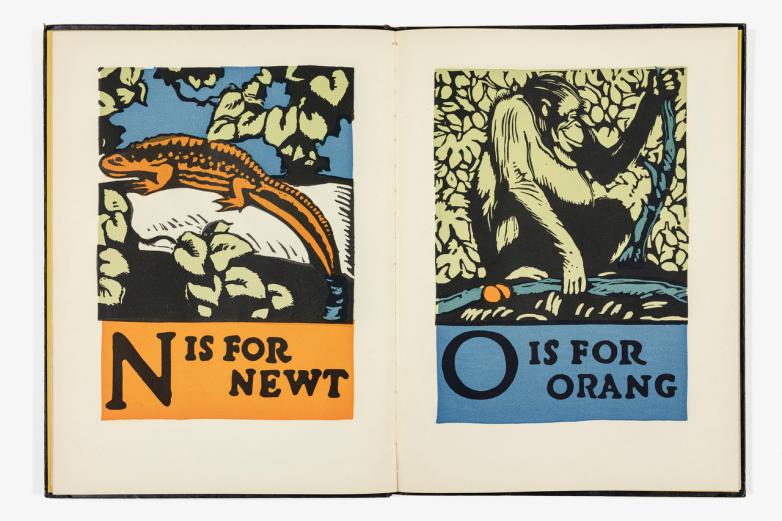“The A.B.C. of Alphabets” Opens at the Grolier Club on Sept. 19

New York — Over the centuries, writers and illustrators have used the alphabet to categorize and enumerate ideas and concepts, to amuse, and, of course, to teach and read. The A.B.C. of Alphabets, drawn from the collection of member Gretchen Adkins, surveys the A to Z of ABCs at the Grolier Club from September 19 through November 2, 2019.
Alphabets have been published for hundreds of years, in a variety of languages and styles, for a multitude of purposes, some aimed at children; others definitely not. The exhibition is organized in six intriguing categories: “A Apple Pie,” “A Was An Archer,” “Manuscripts,” “Alphabets Are Not Just For Children,” “The Letter N,” and “Advertising.”
A Apple Pie (200 Years of the Famous Nursery Rhyme)
The nursery rhyme “A Apple Pie” has been known since 1671 when it was quoted in the writings of the minister John Eachard. The text is unusual in its use of verbs: “A ate it,” “B bit it,” “C cut it,” etc. The exhibition covers 200 years of the rhyme, from its first recorded appearance until the publication of Kate Greenaway’s 1886 best-seller.
A Was an Archer (Alphabets of Professions)
Like A Apple Pie, A was an Archer has a long history. It first appeared in the early 18th century, and remained popular throughout the 19th century, produced in a wide variety of editions from cheap chapbooks, to large books in color. Each letter refers to a profession or a trade: “A was an Archer,” “B was a Butcher,” “C was a Captain,” “D was a Drunkard,” and so on. Although it was more popular in England, alphabets of professions can be found in various languages, notably the 1920 French edition of A est un Archer.
Alphabets are Not Just for Children (ABCs for Adults)
Most people associate alphabets with children and childhood, but that is not always the case, and many writers and illustrators have taken sly pleasure in turning a genre that is usually aimed at teaching children into entertainment for adults.
In Kissed Again--Part of the Bargain, the shenanigans of Countess Screwvinsky (alias Beatrice Wood) and her “admirers” are definitely not directed at those learning to read. This playful alphabet of advice to a would-be courtesan comes from the woman who was in a ménage-à-trois with Marcel Duchamp and Henri-Pierre Roche. Their relationship was the inspiration for Truffault’s film, Jules and Jim. And the authors of Freud’s Alphabet and Ballet Alphabet, a Primer for Laymen by Lincoln Kirsten, illustrated by Paul Cadmus, certainly had a mature audience in mind.
Manuscripts
Six manuscripts offer a range of work from personal reflections to a universal depiction of objects. Among them is an Untitled Alphabet by Basil Withy (B.W.), who died July 2, 1916 at the Battle of the Somme when he was 30 years old. The son of a wealthy ship owner, Withy’s alphabet references family, friends and household staff before he left to fight in World War I.
The Letter N (The Challenge of Finding Animals to Represent N)
Alphabets devoted to animals may be challenged to find examples (other than birds) beginning with the letter N.
Each book in the exhibition illustrates a separate solution. C.B. Falls, in his 1923 ABC Book, chose the Newt to solve his N problem. “Noah,” as in Noah’s Ark ABC, is occasionally the solution. Some imaginative authors, such as Gus. Av. Friendly, have forsaken the zoological world altogether and created their own four-legged universe.
Advertising (26 Selling points!)
Advertising pamphlets, printed on cheap paper and widely distributed, are a relic of the past. They sold anything and everything, from heavy machinery to food and drink, and many used the familiar and comfortable A-to-Z framework to enumerate their selling points: 26 reasons to buy life insurance, for instance.
The Alphabet Book of Coca Cola from 1928 (when a Coke cost 5 cents) is a classic, offering 26 rhyming verses on the merit of the beverage. Every nationality and level of society is illustrated in full color enjoying the carbonated drink. It even offers a testimonial from The United States Supreme Court.
Free Lunchtime Exhibition Tours:
September 25 and October 2, 16, and 30, 1:00 – 2:00 pm. Curator Gretchen Adkins will offer a free guided tour of the exhibition. Open to all, no reservations required.















